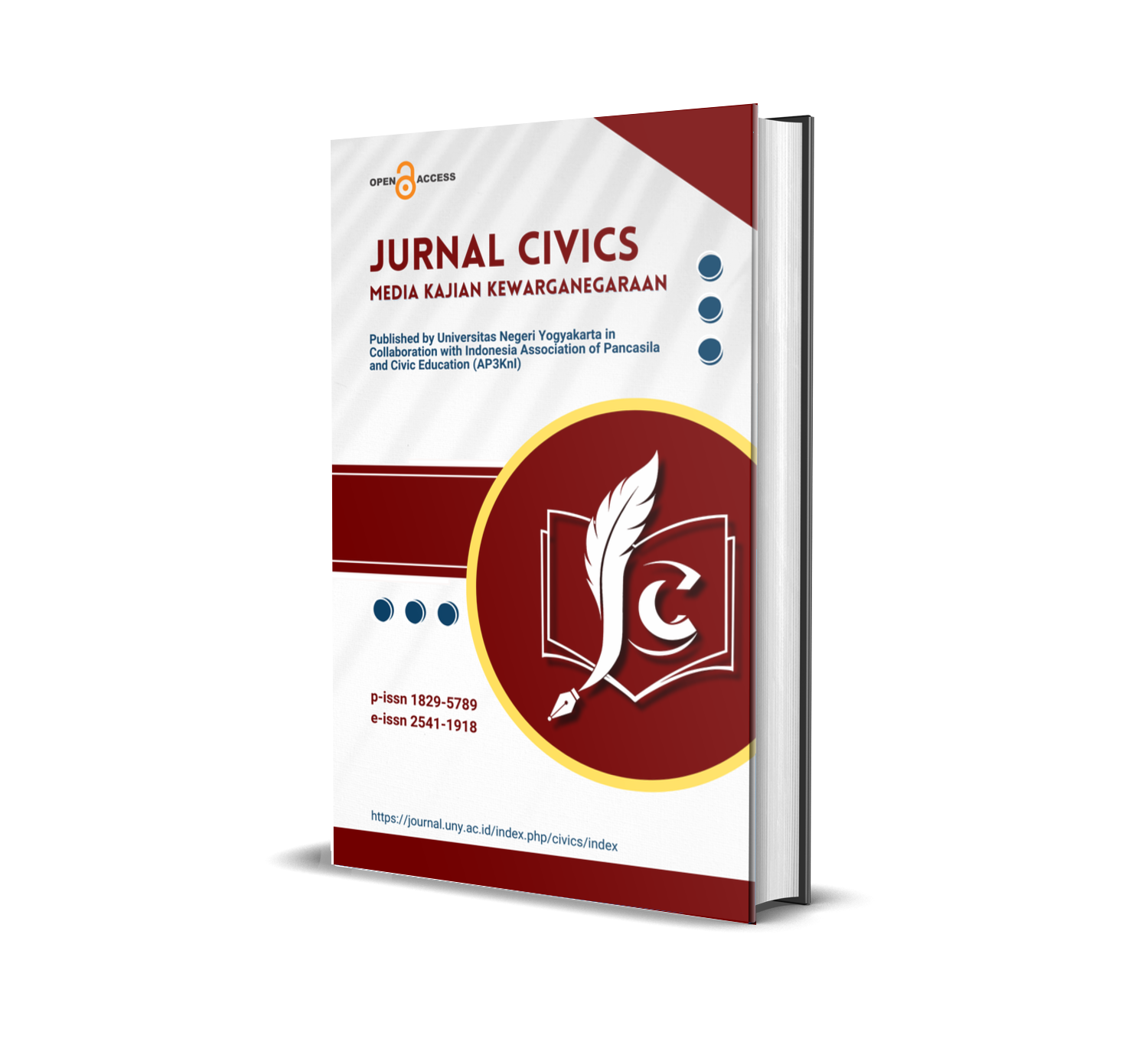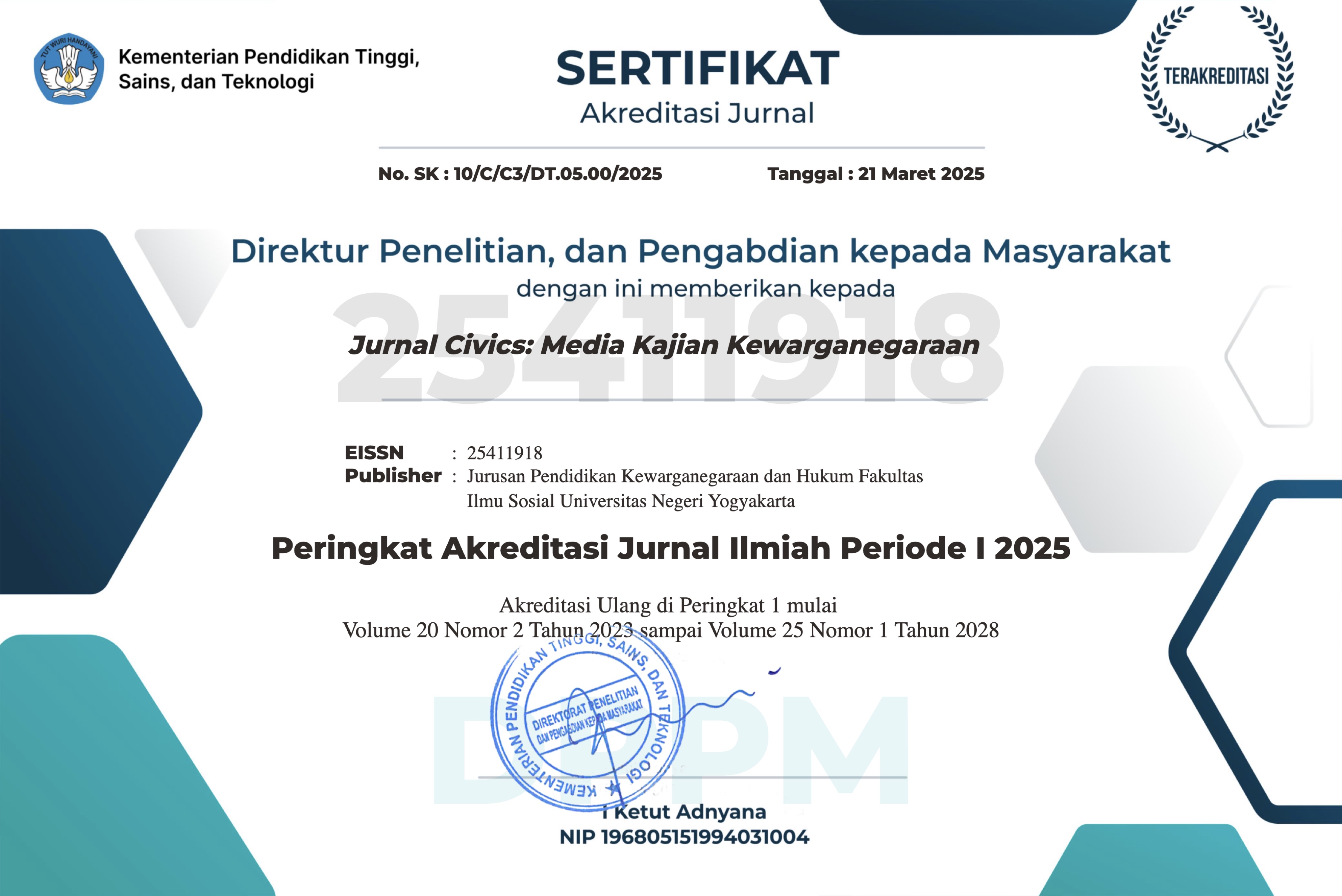Developing students' civic responsibility using blended learning model with an asynchronous system
DOI:
https://doi.org/10.21831/jc.v21i1.67361Keywords:
Asynchronous, blended learning, civic responsibilityAbstract
The development of technology and the world of education today requires complex thinking. Technology can be used to make the learning process easier, more interesting, and more enjoyable. However, learning must continue to focus on the elements of competency achievement that must be achieved and the humanist element. The blended learning model with synchronous and asynchronous systems is one model that can be used in today's technology-based learning era, especially asynchronous systems. This study aims to determine the effectiveness of asynchronous learning in increasing the students' civic responsibility at one of the universities in Bandung City. Experiments in research are considered more appropriate for answering the research objectives. The research subjects were students of the environmental engineering study program (experimental class) and food engineering study program (control class). The results showed that asynchronous learning was more effective for increasing students' civic responsibility, with an average post-test score of 91.50.
References
Belladonna, A. P., & Anggraena, S. N. (2019). Penguatan pengetahuan kewarganegaraan (civic knowledge) dalam meningkatkan kesadaran hukum mahasiswa. Jurnal Pendidikan Kewarganegaraan, 3(2), 196. https://doi.org/10.31571/pkn.v3i2.1442
Branson, M. S. (1998). The role of civic education. Communitarian Network.
Cahyono, C., Danial, E., Affandi, I., & Masyitoh, I. S. (2022). The effectiveness of blended learning with the syncronous and asyncronus system in Civic Education courses. Proceedings of the Annual Civic Education Conference (ACEC 2021), 636, 53–55. https://doi.org/10.2991/assehr.k.220108.010
Center for Civic Education. (1994). National Standards for Civics and Government. Center for Civic Education.
Chaeruman, U. A. (2013). Merancang model blended learning [Designing blended learning model]. Jurnal Teknodik, 17(4), 399. https://doi.org/10.32550/teknodik.v17i4.482
Creswell, J. W. (2013). Research Design: Qualitative, quantitative, and mixed methods approaches. SAGE Publications, Incorporated.
Erwin, M. (2011). Pendidikan kewarganegaraan Republik Indonesia [Civic Education of the Republic of Indonesia]. Refika Aditama.
Fahmi, M. H. (2020). Komunikasi synchronous dan asynchronous dalam e-learning pada masa pandemic COVID-19 [Synchronous and asynchronous communication in e-learning during the COVID-19 Pandemic]. Jurnal Nomosleca, 6(2), 68–76. https://doi.org/10.26905/nomosleca.v6i2.4947
Heinze, A., Procter, C., & Scott, B. (2007). Use of conversation theory to underpin blended learning. International Journal of Teaching and Case Studies, 1(1–2), 108–120. https://doi.org/10.1504/IJTCS.2007.014213
Herring, M. C., Koehler, M. J., Mishra, P., Rosenberg, J. M., & Teske, J. (2016). Introduction to the second edition of the TPACK handbook. In M. C. Herring, M. J. Koehler, & P. Mishra (Eds.), Handbook of Technological Pedagogical Content Knowledge (TPACK) for Educators (pp. 3–29). Taylor & Francis.
Jumaini, J., Hertin, H. H., Nisfiyati, M., & Ibrahim, M. (2021). penerapan metode pembelajaran blended learning dalam meningkatkan pemahaman konsep hasil belajar siswa: Sebuah meta - analisis. Al Khawarizmi: Jurnal Pendidikan dan Pembelajaran Matematika, 5(1), 48. https://doi.org/10.22373/jppm.v5i1.9805
Mulyono, B. (2017). Reorientasi civic disposition dalam kurikulum pendidikan kewarganegaraan sebagai upaya membentuk warga negara yang ideal [Reorientation of civic disposition in the civic education curriculum as an effort to form an ideal citizen]. Jurnal Civics: Media Kajian Kewarganegaraan, 14(2), 218–225. https://doi.org/10.21831/civics.v14i2.17007
Quigley, C. N., & Bahmueller, C. F. (1991). Civitas: A framework for civic education. Center for Civic Education.
Sudarman, S., & Mulawarman, U. (2018). Pengaruh strategi pembelajaran blended learning terhadap perolehan belajar konsep dan prosedur pada mahasiswa yang memiliki self-regulated learning berbeda. Jurnal Pendidikan Dan Pembelajaran, VOLUME, 21(March), 107–117.
Sugiyono. (2016). Metode penelitian kuantitatif, kualitatif dan R&D [Research methods of quantitative, qualitative and R&D]. PT Alfabet.
Sundayana, R. (2018). Statistika penelitian pendidikan [Educational research statistics]. Alfabeta.
Surahman, S. (2013). Dampak globalisasi media terhadap seni dan budaya indonesia [The impact of media globalization on indonesian art and culture]. Jurnal Komunikasi, 2(1), 29–38.
Zemmrich, E. (2020). Making sense of shifts in perspectives: Perceiving and framing examples of interreligious learning in Indonesia. Islam and Christian–Muslim Relations, 31(2), 151–172. https://doi.org/10.1080/09596410.2020.1782096
Downloads
Published
How to Cite
Issue
Section
Citation Check
License
The authors agree to transfer the transfer copyright of the article to The Jurnal Civics: Media Kajian Kewarganegaraan effective if and when the paper is accepted for publication.
Authors and other parties are bound to the Creative Commons Attribution-NonCommercial-ShareAlike 4.0 International License for the published articles, legal formal aspect of journal publication accessibility refers to Creative Commons Attribution-NonCommercial-ShareAlike 4.0 International License (CC BY-NC-SA).










